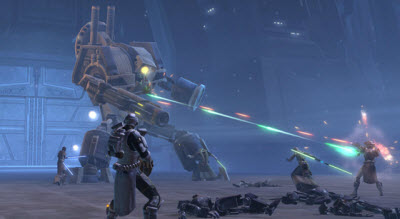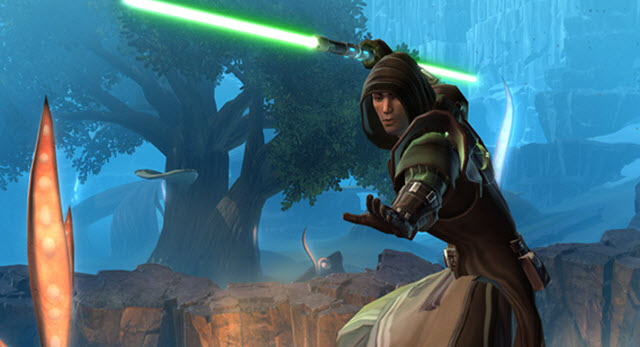BioWare’s epic new online game Star Wars: The Old Republic debuts on Tuesday. A persistent world known as a massively multiplayer online game (MMO), the title is one of the most ambitious video games in history. One of its many lofty goals is to challenge World of Warcraft, the seven-year-old fantasy role-playing world that is the world’s biggest money-making online game with more than 10.3 million paying subscribers and around a billion dollars a year in revenue. Another is to take the Star Wars fan base and bring it into the modern age of the MMO, ensuring that George Lucas’s franchise lives on in the age of massive blockbuster games. And it is also aimed at bringing in a steady stream of revenue for Electronic Arts, elevating it and its developer BioWare into the stratosphere of the game industry, where respect and revenues go hand in hand.
 If the game is a home run for EA, then the company will enjoy a cash-generating franchise for years to come, much like its EA Sports games that generate revenues every time a new sports season comes around. And it could give EA more financial might to take on its larger rival, Activision Blizzard, and fend off challengers such as Zynga in social games and smaller rivals in smartphone and tablet games. This kind of risk-taking is almost unheard of in the game industry these days.
If the game is a home run for EA, then the company will enjoy a cash-generating franchise for years to come, much like its EA Sports games that generate revenues every time a new sports season comes around. And it could give EA more financial might to take on its larger rival, Activision Blizzard, and fend off challengers such as Zynga in social games and smaller rivals in smartphone and tablet games. This kind of risk-taking is almost unheard of in the game industry these days.
The title is as big a bet as they come, with a long history behind it. BioWare began working on its first MMO around five years ago, opening a new satellite studio in Austin, Texas. The developer was then majority owned by Elevation Partners, which took a majority stake in two development firms, BioWare/Pandemic, for $300 million in 2005. Elevation partner John Riccitiello was then named CEO of Electronic Arts and EA announced it would acquire BioWare/Pandemic for $860 million in October 2007, with the deal closing in 2008. One of the reasons that BioWare/Pandemic had doubled in value in just two years was that then-secret online game was expected to generate a lot of revenues in the future.
EA announced that both LucasArts and EA would publish the BioWare Star Wars game in October 2008. At that time, BioWare co-founders Ray Muzyka and Greg Zeschuk announced that the game has more content planned than all of BioWare’s previous games, including the 2003 title Knights of the Old Republic. Twelve writers were working on the story full-time, and they were putting BioWare’s signature emotion-driven storytelling into the game. Those writers are needed, along with a huge team of developers, because the game is envisioned as a never-ending service, with new installments of episodic content coming out on a regular basis. It is a major shift for EA from one-time purchases toward games-as-a-service.
 Then EA acquired LucasArts’ co-publishing position and opted to publish the game on its own. Industry observers have guessed that the game’s budget must be around $100 million, but EA has said that previous estimates were wrong and that it isn’t disclosing the precise figure. Besides setting up the studio in Texas, EA also created its Origin online game distribution service and opened a 200-employee customer service center in Galway, Ireland, to handle support calls related to the game.
Then EA acquired LucasArts’ co-publishing position and opted to publish the game on its own. Industry observers have guessed that the game’s budget must be around $100 million, but EA has said that previous estimates were wrong and that it isn’t disclosing the precise figure. Besides setting up the studio in Texas, EA also created its Origin online game distribution service and opened a 200-employee customer service center in Galway, Ireland, to handle support calls related to the game.
During the long development, the video game industry has changed. World of Warcraft challengers and virtual worlds have fallen by the wayside. Console game sales have stalled in the U.S., and free-to-play online games created by companies such as Nexon, which raised $1.2 billion in an initial public offering last week, have grown dramatically. Zynga was born and grew to a giant size in Facebook gaming and even held its $1 billion IPO all within a shorter time span than the making of Star Wars: The Old Republic. Still, EA has kept a steady hand, investing in the game during lean times and during its recovery.
Earlier this year, Riccitiello said Star Wars: The Old Republic needs 500,000 paying subscribers to break even and 1 million subscribers to be profitable. If Electronic Arts gets 1.5 million to 2 million subscribers, it will be enough to “make it look like a great investment and justify the purchase of BioWare Pandemic, Riccitiello said. The high-end numbers may seem overly ambitious, but in the past year, World of Warcraft has lost around 1.7 million paying subscribers, leaving plenty of former Warcraft fans ripe for the picking. But other games are attempting to grab Activision Blizzard’s users as well, such as the fantasy role-playing game world Rift, launched this year by Trion Worlds. Trion has said that more than 1 million players signed up for Rift in its first four months.
Atul Bagga, an analyst at Lazard Capital Markets, said in a recent note that his survey of MMO players suggests a “strong tailwind” for Star Wars: The Old Republic. He estimated that the game may find a receptive audience among 3 million to 4 million players within the World of Warcraft subscriber base. About 50 percent of World of Warcraft subscribers plan to buy the EA game. Among those who played the beta test, about 90 percent plan to buy the game. And 87 percent have either pre-ordered or plan to pre-order the game. And it seems that Facebook isn’t stopping those players from trying out the Star Wars game. About 55 percent of the players surveyed are currently playing games on Facebook. But Bagga said that a weaker-than-expected reception for the Star Wars game could very well hurt EA’s stock price.
Bobby Kotick, chief executive of Activision Blizzard, has suggested that EA will likely have to spend a lot of its profits to pay Lucas for the rights to the Star Wars franchise on an ongoing basis. EA dismissed that as sniping from a competitor. In many ways, World of Warcraft and Star Wars: The Old Republic are complementary, as one is fantasy and the other is science fiction. On the other hand, there have been a limited number of gamers who are willing to pay $15 a month for an MMO subscription.
Michael Pachter, an analyst at Wedbush Securities, said, “I think SWTOR is on track to sell 2 million units the first few weeks, and if the game is good after 30 days, I expect 1.5 million of the initial purchasers to sign up for subscriptions. Let’s see if the game is good, first, then we can talk about its potential.”
EA has also touted some promising preorders and beta test numbers. EA has said that millions of players have already tried the game and they have already formed more than 78,000 guilds. Those who pre-ordered the game were able to start playing on Dec. 13, and on Tuesday, Dec. 20, other players can join in. EA has promised a smooth launch. The game costs $60 to purchase, and monthly subscriptions cost $14.99 a month, the same as World of Warcraft, or $77.94 for six months. The game will have English, French and German versions.
Reviewers have come in with a variety of opinions. Game Informer magazine has proclaimed that “The Old Republic is poised to reshape the MMO landscape,” and MSNBC said that “Star Wars: The Old Republic is looking strong and the attention to story is paying off in a big way.”
The story is set thousands of years before the classic Star Wars films, when the Jedi ruled the galaxy. Players can go on quests and engage in combat across a number of iconic worlds such as Tatooine, Alderaan, Hoth and others. The game has eight different character classes, all of them voiced by an army of actors. There’s no Darth Vader in this era, but there are plenty of Sith and other forces to battle. The game play emphasizes cinematic stories and forces the players to make meaningful personal choices.
In an interview with Industry Gamers, Zeschuk said, “We have research that shows that a lot of people have been waiting for this game. We’re seeing huge demand for it, and we plan to support it long-term.”
And BioWare co-founder Muzyka said, “There’s more competition for entertainment dollars now than ever before from social and play for free, and all sorts of entertainment, which I think is actually really healthy from an entertainment industry perspective. But I agree with Greg that there’s a space for a certain number of premium products that are subscription based or whatever the premium pricing model is. But they have to merit it, they have to earn that from a consumer trust perspective and delivering and exceeding expectations. I think The Old Republic is definitely in that triple-A premium category. That’s the feedback reading from the players and data testing.”
